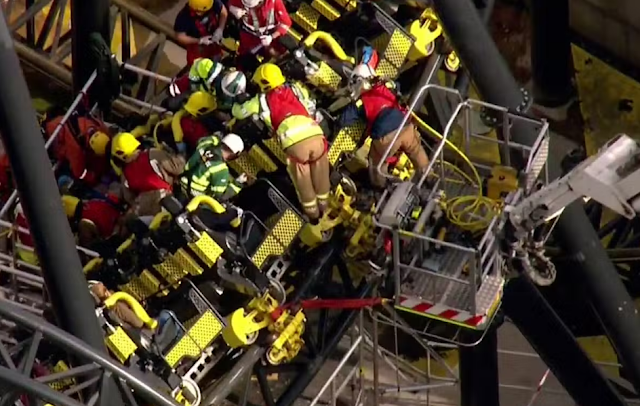Fascinating Horror - At 1:51pm on the 2nd of June 2015 at the Alton Towers theme park in the UK a combination of factors lead to a fully-loaded car on the Smiler rollercoaster crashing into an empty stationary car at speed.
This incident was the worst roller coaster crash in the history of the park and resulted in serious, life-changing injuries for several of the passengers on board.
It is down only to good fortune that nobody was killed.
The Smiler is a steel roller coaster manufactured by Gerstlauer which opened in the X-Sector zone of Alton Towers in May 2013.
The track included a world-record-beating 14 inversions and was themed with several special effects.
These included hypnotic spinning discs, sprays of mist, and flashing video screens - all things that according to the story behind the ride were designed to manipulate guests into smiling.
The ride was initially popular despite a number of setbacks.
During a press preview the ride stalled on a vertical lift hill requiring celebrities and journalists to be rescued from the train - a process that took several hours.
This incident resulted in the opening day of the ride being pushed back twice to the very end of the month, frustrating many guests who had booked hotel stays specifically to ride the new roller coaster.
Once the ride had opened the issues continued.
In 2013, along with several incidents of cars stalling on the batwing element of the track, nearly 50 guests were evacuated from the ride after a bolt fell from one of the joints in the track causing a very small gap to appear between two track sections.
In a separate incident months later several plastic guide wheels fell from one of the trains causing minor injuries to four riders.
These were, however, minor incidents compared to the one that would take place on a sunny day in June 2015.
The roller coaster had been operating normally all morning despite blustery winds of 46 miles per hour.
Guidelines for the operation of the ride stipulated that it should not be operated in winds of more than 34 miles per hour.
Indeed, the high winds had resulted in the closure of at least one other ride in the park.
Shortly after 1:00pm a ride operator noticed a warning light indicating a fault with the ride.
Riders were removed at the station, the ride was temporarily closed, and engineers were called to the scene.
Until this point there had been four cars in operation on the ride.
Staff had been just about to add a fifth car to the track to help increase rider throughput - a normal thing to do on such a busy day.
While engineers worked to resolve the fault staff added this extra car.
After dealing with the original fault, and then another that cropped up right after, engineers were ready to restart the ride.
They sent around an empty test car which failed to complete a loop and stalled on the Cobra roll section of the ride.
This was not known to staff and, due to some confusion about how many cars were on the track, engineers believed that the test car had completed its circuit and the track was clear.
The ride was reopened and a car fully loaded with passengers was dispatched.
Automatic safety systems halted this train just before the cobra roll section of the ride.
The computer system indicated to operators that the track ahead was occupied.
One engineer, still under the impression that four cars in total were in use, concluded that the stalled car which the ride had detected, was down to a glitch.
He and his colleague overrode the safety warning and set the fully-loaded car moving again.
It plummeted down through the loop above which it was held, entered the cobra roll and smashed at speed into the stalled test car.
Passengers on board were left with devastating injuries, the severity of which would be worsened by the length of time it would take to remove them from the ride.
It took around 20 minutes for the first call to emergency services to be placed, and around 4 to 5 hours for rescuers to construct a temporary scaffold tower beneath the ride in order to reach the injured parties.
During this time several of them suffered significant blood loss.
All 16 victims survived the crash and were transported to hospital.
Two young women were forced to undergo leg amputations due to the injuries sustained.
To their credit Merlin Attractions Operation LTD (who owned Alton Towers) cooperated fully with the investigation that ensued.
From the beginning they offered their full support to the victims and took responsibility for the accident.
A long investigation concluded that it was down primarily to human error, but that adjustments to the ride system would also have prevented the crash.
Merlin Attractions Operation was given a hefty fine by the Health and Safety Executive.
Multiple adjustments were made to the ride system and staff were fully retrained.
With these changes complete the Smiler roller coaster reopened less than a year after the crash, in a move that garnered some severe negative press for the park.
It has, however, gone on to have a clean safety record since and is now a popular ride within Alton Towers.
If you visit the park you can even ride it yourself.
The Smiler will run for many more years.
The park itself will continue to welcome guests...but for the victims of the Smiler roller coaster accident life will never again be the same.
(The Smiler Rollercoaster Crash)







Post a Comment
Post a Comment